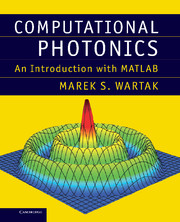Book contents
- Frontmatter
- Contents
- Preface
- 1 Introduction
- 2 Basic facts about optics
- 3 Basic facts from electromagnetism
- 4 Slab waveguides
- 5 Linear optical fibre and signal degradation
- 6 Propagation of linear pulses
- 7 Optical sources
- 8 Optical amplifiers and EDFA
- 9 Semiconductor optical amplifiers (SOA)
- 10 Optical receivers
- 11 Finite difference time domain (FDTD) formulation
- 12 Beam propagation method (BPM)
- 13 Some wavelength division multiplexing (WDM) devices
- 14 Optical link
- 15 Optical solitons
- 16 Solar cells
- 17 Metamaterials
- Appendix A Basic MATLAB
- Appendix B Summary of basic numerical methods
- Index
12 - Beam propagation method (BPM)
Published online by Cambridge University Press: 05 July 2013
- Frontmatter
- Contents
- Preface
- 1 Introduction
- 2 Basic facts about optics
- 3 Basic facts from electromagnetism
- 4 Slab waveguides
- 5 Linear optical fibre and signal degradation
- 6 Propagation of linear pulses
- 7 Optical sources
- 8 Optical amplifiers and EDFA
- 9 Semiconductor optical amplifiers (SOA)
- 10 Optical receivers
- 11 Finite difference time domain (FDTD) formulation
- 12 Beam propagation method (BPM)
- 13 Some wavelength division multiplexing (WDM) devices
- 14 Optical link
- 15 Optical solitons
- 16 Solar cells
- 17 Metamaterials
- Appendix A Basic MATLAB
- Appendix B Summary of basic numerical methods
- Index
Summary
In this chapter we summarize the beam propagation method (BPM). The method is widely used for the numerical solution of the Helmholtz equation and also for the numerical solution to the nonlinear Schroedinger equation (to be discussed in Chapter 15 dealing with solitons). It is the most powerful technique for studying the propagation of light in integrated optics. The method was originally introduced by Feit and Fleck in the late 1970s [1]. The BPM was initially based on FFT algorithm. Later on it has been extended to finite-difference based BPM schemes (FD-BPM) and finite-element BPM (FE-BPM) and many others. The main characteristics [2] of FD-BPM are the ability to simulate structures with large index discontinuity, less memory and time consumption in modelling complex structures, the possibility to incorporate wide-angle and full vector algorithms and the ability to incorporate transparent boundary conditions.
There is a large number of algorithms available in the literature and almost all of them are based on the concept of a propagator. Propagators are mathematical ‘objects’ which propagate fields from one space coordinate to another. An example of the system where propagation takes place, known as an optical waveguide, is shown in Fig. 12.1. It splits input optical signal into two arms, see also Fig. 12.2. The role of BPM is to determine field profile along the waveguide knowing the distribution of refractive index over the whole waveguide.
- Type
- Chapter
- Information
- Computational PhotonicsAn Introduction with MATLAB, pp. 288 - 315Publisher: Cambridge University PressPrint publication year: 2013



